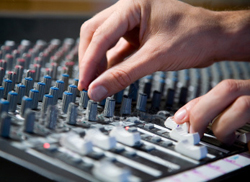
So if the center frequency of the mid-range control is 3 kHz, it will effect frequencies as high as 6 kHz and as low as 1.5 kHz. By the way, this two-octave range of frequencies comprises most of what we hear, and is also at the heart of most human voices.
The overall mid-range frequency band can be as low as 100 Hz and up to as high as 3 kHz. A bass instrument typically plays from about 30 Hz up to about 240 Hz, while a bass vocalist (think gospel quartet) is in the 55 Hz to 500 Hz.
All vocalists, from the lowest frequencies to the highest, will therefore range from about 55 Hz and up, all the way to about 1.7 kHz (think soprano).
This is then the frequency range where we can make the voice of the person speaking or singing sound crisp and clear (or dull and lifeless).
Note that some consoles are now also equipped with a “mid-low” frequency and/or “mid-high” frequency knobs.
Simply, these knobs provide the operator with even more ability to adjust and fine-tune the crucial frequencies in the mid-range. (Again, it’s the frequency range of what we hear most.)
Just A Little Time
So, how do you get comfortable using these controls? It’s not difficult and can be fun if you enjoy your calling and have a little time. Just plug a mic into the console start to speak into it, and set all three knobs straight up to “0” – no cut, no boost.
While talking, cut and then boost the high knob, and note the effect it has on your voice. Then do this with each control so you can hear what happens in each frequency range.
There is no magic here, and not much to fear unless you like to listen at real high levels. By the way, I highly recommend doing this too.
Turn it up until some feedback is produced and see which frequency range cuts out the feedback. (This is best done when others aren’t present.)
Also play some music through the system and do the same cuts and boosts. You’ll soon be surprised at what you hear and don’t hear.
The point is to understand the frequencies and what they correlate to, and to be up-to-speed on using the EQ knobs to tailor the sound for pleasing and effective results.
The next time you’re working “live” with a person speaking or performance, you’ll then know how to make it sound even better.
